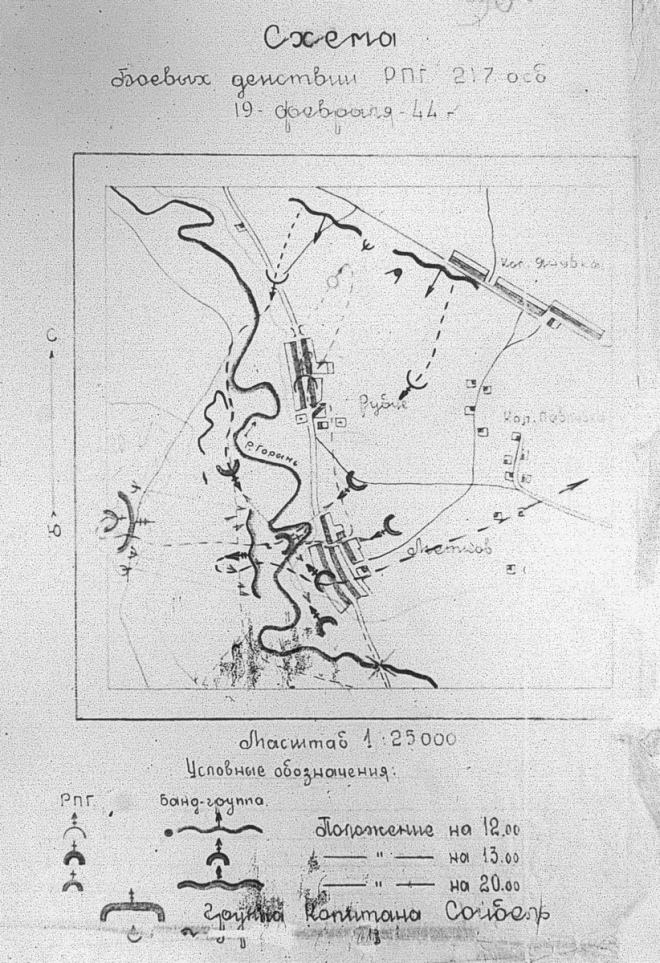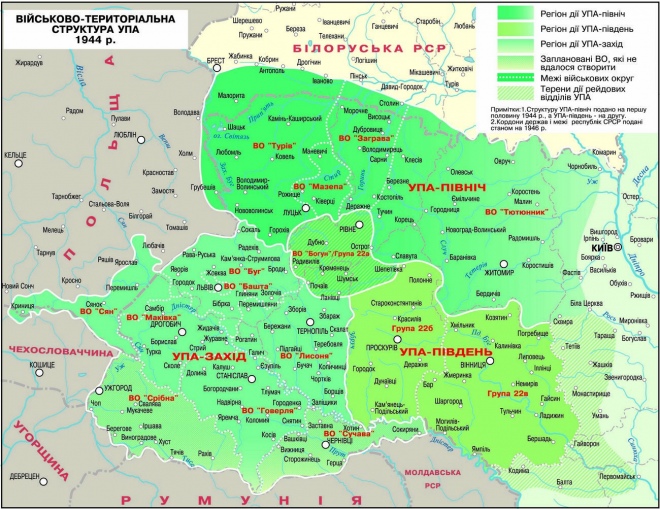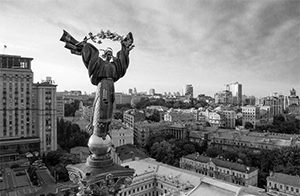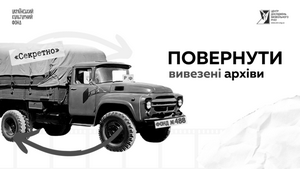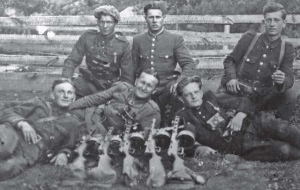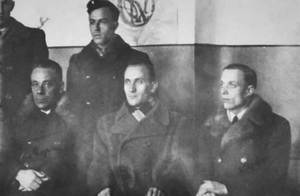Stalin's "Fight Against Banditry." Round One: 1944
A unit of the 1st Battalion of the 220th Border Regiment of the NKVD suffered a crushing defeat in a battle with the UPA-North Brigade "Pamyat Bazaru".The unit was surrounded, divided into several groups, and eventually almost completely destroyed. The battle took place on the anniversary of the execution by the Chekisks of 360 captured participants of the Second Winter March of the Army of the Ukrainian People's Republic in 1921 near the village of Bazar. Thus, the UPA-North brigade symbolically repaid the Communists for the deaths of Ukrainian soldiers.
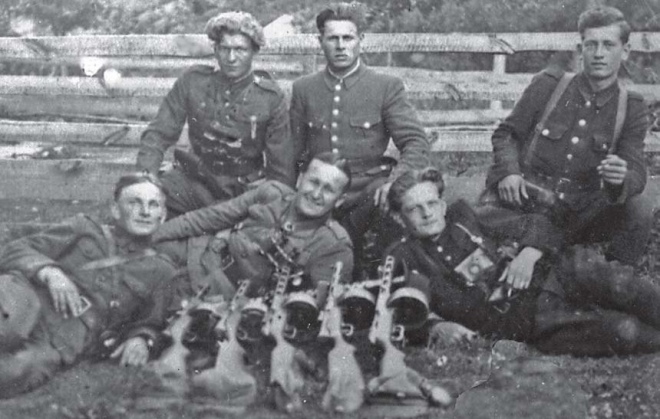
The year 1944 was a turning point: finally, two uncompromising opponents came together in an open duel - the Ukrainian liberation movement and the communist totalitarian regime. In January-March of 1944, the Red Army expelled the Nazi occupiers from Rivne and most of Volynia Oblast, after what it took Rivne and Lutsk. By mid-April, the German Wehrmacht had left Bukovyna, half of Ternopil region, including the regional center, as well as Pokuttia. The front line stabilized by July 1944, and Soviet power returned to the east.
So, while units of the UPA-West continued to fight in the rear of German and Hungarian troops, UPA-North and UPA-South in Volynia, Polissia and Podolia crossed the front line in February-March 1944 and fought against Soviet units.
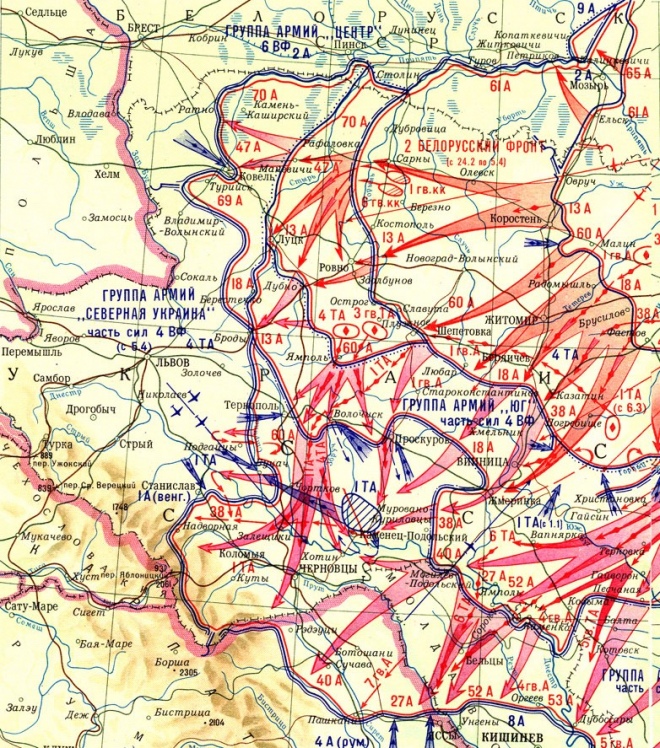
Both sides were preparing for this. Volynia units of the UPA underwent a one-year school of guerrilla warfare against German SS and police units, as well as against red partisan units. The leaders of the Communist Party knew from the reports of the agents and partisans themselves that in Western Ukraine they would be welcomed, but "greeted" with fire and bullets. Therefore, in the liberated territories, together with the civilian administration, a powerful force was deployed, that wasn't worse than the one the Nazis had at their disposal.
The first clashes of Ukrainian insurgents with Soviet forces took place in the second half of January 1944 in the east of Rivne region. By the movement of the front line to the west, NKVD troops fought the UPA-North detachments of the "Zagrava", "Bohun", and "Turiv" groups to protect the rear of the 1st Ukrainian Front and part of the regular Red Army. The instructions of the UPA Main Military Staff and the lower headquarters instructed their subordinates to avoid fighting with the Red Army and to treat the prisoners of war humanely. However, the harsh reality made its adjustments—sometimes it was simply impossible to avoid.
In an order to the detachment commanders (March 8, 1944), the headquarters of the "Zagrava" Group described the situation as follows: "Yesterday we fought against German imperialism, against the German Gestapo, Hitler's party and their Polish allies. Today there is one less enemy. We are fighting against Moscow imperialism, against the Stalinist regime, against the party, the NKVD and their servants, who are ready to help every enemy of the Ukrainian people, the Poles."
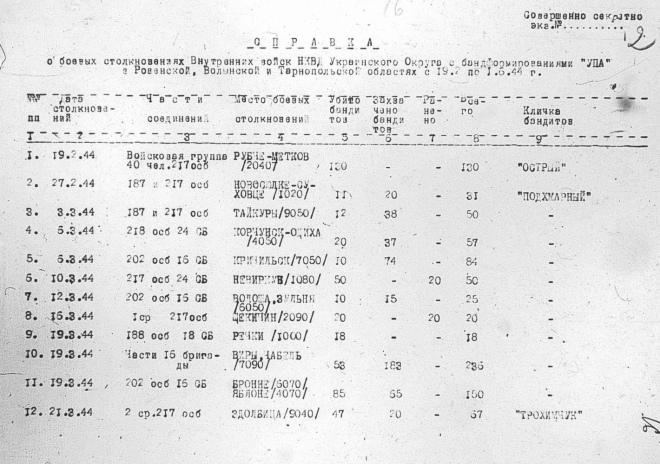
As we can see, the "palm of supremacy" of the anti-insurgency struggle belongs to the 211th barricading detachment of the NKVD Border Troops, although the Soviet command also put field units of the Red Army against the UPA.
Ukrainian District of the NKVD Internal Troops
However, the main burden of "pacification" of disobedient "bandits" rested on specially appointed structures. Units and formations of the Internal Troops (VV) of the NKVD of the Ukrainian District (UO) were deployed in the rear of the front troops of the RKKA. They were the main strike force in liaison with the NKVD's territorial anti-banditry units, which operated the agency; they conducted operational activities against the OUN and UPA, and investigated captured members of the underground groups.
It was impossible to do without small blood. A number of elements of the 16th and 24th infantry brigades of the NKVD, assigned in February 1944 to suppress the insurgent movement in Volynia-Polissya, proved to be far from sufficient. Therefore, the commander of the NKVD UO, Major General Mikhail Marchenkov, transferred 2 more rifle divisions, 5 rifle brigades, 2 rifle regiments, a cavalry regiment, and an independent tank battalion (22 tanks) to the region during February-March. The 1st Ukrainian Front provided the Chekists with 8 light tanks and 18 armored vehicles. Together, this contingent numbered 37,208 soldiers who were free from conducting military actions at the front, and fought only against Ukrainian insurgent units.
Thus, on March 30, 1944, the "fight against banditry" was carried out by:
-
16th, 17th, 19th, 20th, 21th and 25th VV rifle brigades in full force;
-
2 battalions of the 18th VV Rifle Brigade;
-
Ordzhonikidze and Sukhum (from April 1944 — 9th and 10th) VV rifle divisions;
-
18th Cavalry Regiment;
-
9th and 10th VV infantry regiments.
Each of these units recorded its operational and combat activities in the form of periodic combat reports, orders, plans and schemes of operations, lists of killed and wounded soldiers, etc. These were top-secret documents sent to the headquarters of the NKVD. Today they are stored in the Central Archive of the National Guard of the Russian Federation, the former Central Archive of the Internal Troops of the USSR Ministry of Internal Affairs.
Copies of the Fonds 488 of the VV NKVD UO Archive are at the disposal of Ukrainian historians, thanks to which we can compile a complete picture of the counter-insurgency of the Soviet regime for each military unit and for each year. The first part of them is already publicly available on the website of the Electronic Archive of the Ukrainian Liberation Movement.
The First Operations
The documents show that at the beginning the command of the Internal Troops hoped to crush the UPA units and the OUN network by force. It seemed that there were more than enough forces for this: almost 40,000 Soviet fighters against 8-9,000 participants in the liberation movement in Volhyn' and Polissia (according to NKVD estimates, current figures reach 10-11,000). Therefore, in the first period after the return of the Soviet regime to the western regions of the USSR, operational-military (otherwise known as Chekist-Military) operations were massively used as State Security tactics.
They were joint actions of local NKVD bodies based on intelligence data and units of the Internal Troops (sometimes border guards) to surround and comb large forests, blockade and inspect settlements in order to defeat large UPA units and arrest members of the underground groups.
As an example of one of the first such operations, we can consider the battle of the 217th Battalion's task force near the villages of Metkiv and Rubche on the banks of the Goryn' River. On February 19, 38 soldiers under the command of Senior Lieutenant Turgenev conducted reconnaissance to identify the "Bulbaites" (the Chekists initially confused the "Bulbaites" with the "Banderites"), when at noon they were attacked by a UPA detachment of 700 fighters strength (fear has magnifying eyes!) with two mortars led by Yaroslav Zhdan-'Ostry'.
From the combat report we learn that under fire from insurgents and locals(!) the task force retreated to the opposite bank of the river, where under the leadership of Lieutenant Dorokhin it took up the defense (the commander went to the headquarters for help). The firefight lasted for 7 hours, while the insurgents, with the help of locals, built a crossing and began to surround the Chekists on several sides.
The Soviet group was saved by machine-gun reinforcements (80 soldiers). With the onset of darkness, they managed to push the rebels to the opposite bank of the Goryn' and retreat to Rivne. The operative group lost 4 soldiers and 7 were missing. But, according to the report, the "bandits" had as many as 133 dead and wounded.
The scheme of the battle of the search group of the 217th independent rifle battalion of the 24th brigade of the Ukrainian Insurgent Army near the village of Rubche of Oleksandriya (now Rivne) district on February 19, 1944
ARCHIVE OF THE VV NKVD UO
However, UPA companies and battalions were not going to sit in the woods. They replenished their ranks, that got tosses during the crossing of the front, and formed new units. The Ukrainian insurgents began to fight with the VV and go on the offensive: to attack raion centres, military units, smash local NKVD stations, party committee, release prisoners etc.
As early as February 20, 1944, a 50-member UPA detachment stormed the raion centre of Derazhne in the Rivne Oblast, forcing the Soviet administration to flee to Tsuman. A two-hour battle in the district center of Volodymyrets took place on February 24 by Makar Melnyk-'Kora' detachment, who were a part of the "Zagrava" Group of the UPA-North (4 communists killed). By the end of the month, the raion centres of Morochne, Vysotsk, and Tuchyn [the administrative division at the time was different than that of nowadays — auth] were attacked by the insurgents.
As we know from the Soviet documents, during the first 5 days of March, UPA members from Rivne carried out 7 more attacks on raion centres, conducted 64 combats in rural areas, 150 times attacked units of the Red Army.
The Soviet leadership became to take UPA-North seriously after the death of the commander of the 1st Ukrainian Front, General Vatutin, as a result of the wound he received in an accidental clash with the UPA unit on February 29 near the village of Myliatyn, Ostrog Raion, Rivne Oblast.
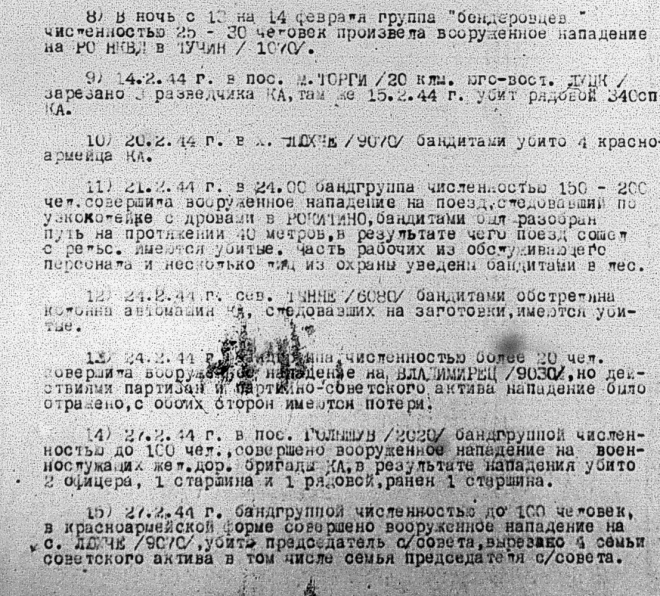
Report with information about the attacks on Tuchyn, Volodymyrets and other actions in February 1944
In total, by the end of the spring, the NKVD UO had 112 clashes with UPA detachments and OUN militants in Volynia and Polissia. In addition, the command conducted three major counter-insurgency operations: Kremenets (April 21-28), Stepan (May 7-11), and an operation in the "Mezhyrichchia Sector", in the Klesiv and Medvediv forests (May 14-15).
According to the statistics of the VV headquarters, 8095 insurgents were killed in these battles, and 4705 'Banderites' were imprisoned.
The mentioned Kremenets operation deserves more attention. After all, this is the famous Battle of Gurby — the biggest battle between the UPA and the NKVD in the history of their confrontation.
At that time, a group of 4,000 to 4,500 soldiers (up to 1,500 were unarmed recruits) was concentrated in the Kremenets and Shumsk forests and surrounding villages on the border of the Ternopil and Rivne regions.
These troops included high-ranking commanders: the commander of the UPA-South, Vasyl Kuk-'Lemish', and the commander of the 'Bogun' Group of the UPA-North, Petro Oliynyk-'Roman' ('Eney'). The UPA-South 'Kholodny Yar' Formation (1,500 to 1,800 fighters) was preparing for a raid on the Kyiv Oblast. In addition, the forests became a haven for thousands of civilians who tried to avoid total mobilization into the Red Army.
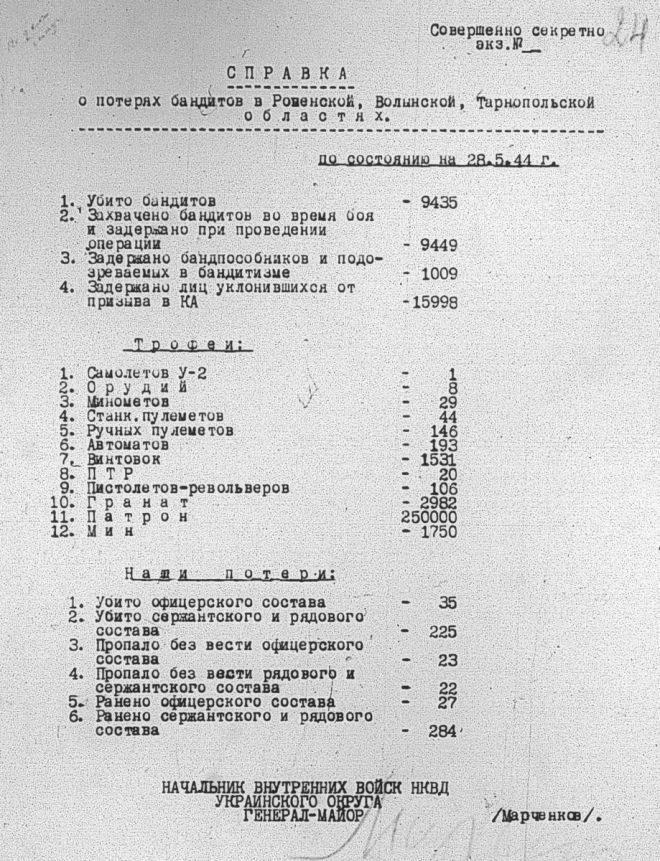
The NKVD intelligence noticed such a concentration, and on April 21, 1944, the Soviet command assembled 14 rifle battalions, an 18th cavalry regiment, and 16 tanks of the F. Dzerzhynsky Special Motorized Rifle Division of the Internal Troops as well as planes of the 6th NKVD Air Regiment (a total of about 15,000 soldiers).
The counter-insurgency operation lasted a week, during which there were 26 clashes with the insurgents. The culmination was a front-line battle with the use of armoured vehicles, artillery and aircraft near the village Gurby, which lasted all day on April 24. The insurgents suffered heavy losses, in particular, covering the gap in the defense, the commander Oleksandr Stepchuk-"Storchan" and his 60 fighters were killed. However, the isurgents did not retreat, and even damaged 2 enemy's tanks.
On the night of April 25, 1944, the units of the "Kholodny Yar" broke through the blockade ring near the village of Bushcha, now in the Rivne Oblast, and the whole group marched in three columns into the Surazh and Derman forests. The cleansing of the Kremenets forests ended on April 28, after which General Marchenkov received a report informing that in 6 days the VV units lost only 11 soldiers, but eliminated as many as 2018 and captured 1,570 UPA fighters!
According to researchers Igor Marchuk and Oleksandr Tyshchenko, the real losses are noted in UPA reports: about 400 dead, half of whom were recruits. The same number of people were imprisoned. According to professor Ivan Patryliak, based on data on the seized weapons, 370-380 insurgents could have been killed, and the losses of mobilized persons and civilians cannot be calculated. But all researchers agree that the losses of the Chekists also amounted to several hundred soldiers killed and wounded.
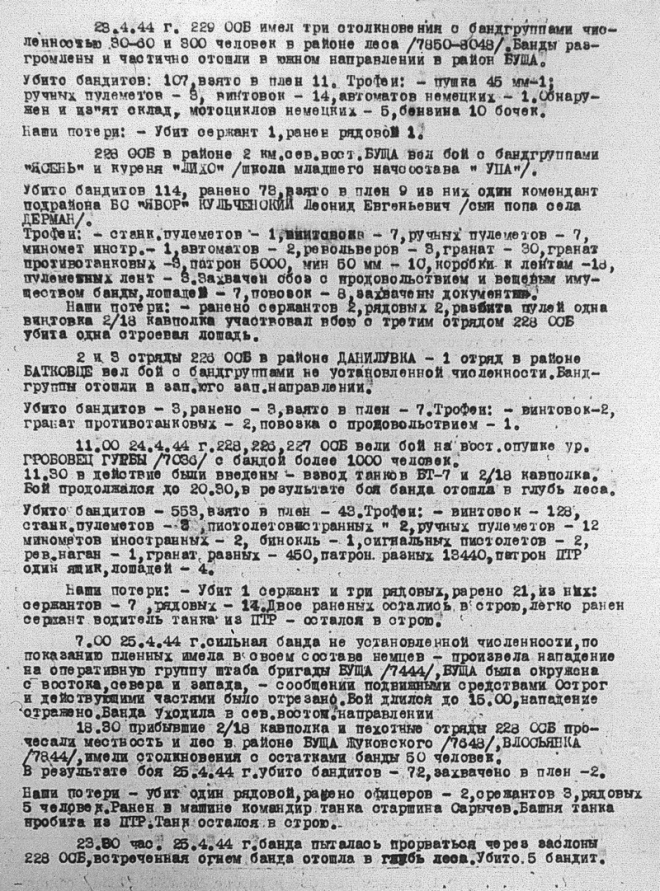
UPA-West Joins Into Force
Battles such as those near Gurby using aircraft and armored vehicles demonstrated to the party and Chekist leadership in Kyiv and Moscow that those they called "gangs" were in fact a motivated, well-trained, and well-equipped military force with experienced command.
In July 1944, the Red Army launched the Lvov—Sandomierz offensive and by early August the rest of the western regions had been cleared of German troops. As expected, the NKVD redeployed the units of the Internal Troops to those areas: the 17th (Lviv and Drogobych Oblasts), 19th (Stanislav and Chernivtsi Oblasts) and 21st (Ternopil Oblast) brigades.
Thus, the UPA-West group joined the anti-Soviet struggle. In Galicia, the forces of the liberation movement had more time to prepare for the transition of the front, they had more human and material resources. Accordingly, the forces of the totalitarian regime met with even fiercer resistance than in Volynia. From the second half of the summer of 1944, the Galicianstructures of the OUN and UPA gradually acquired a leading role in the struggle.
It is known that in August 1944 only in the Lviv region NKVD troops conducted 220 Chekist military operations, which eliminated, according to official (exaggerated) data, about 5,000 insurgents. On August 19, self-defense units "Buh" attacked the Komarno raion centre, releasing 25 prisoners.
On August 29, the "Galaida" battalion (about 450 people) was surrounded in the forest near the village of Piddubne by a troop of 250 soldiers of the VV, 450 soldiers of the 104th Border Regiment and 150 cavalrymen of the 29th Guards Regiment with the support of a mortar battery. After three hours of artillery training, the Soviets unsuccessfully stormed the insurgents' positions from 9:00 a.m. to 4:00 p.m., fired from 6:40 p.m. to 7:30 p.m., and then attacked again until 9 p.m. Under cover of night, Dmytro Pelyp-"Em's" ("Yevshan's") rifleman managed to break out of the ring.
The Chekists recorded 625 killed insurgents (more than there were) and acknowledged 32 of their losses. The insurgent documents contain information about 10 killed and as many as 300 enemy victims.
At the same time, on August 26, in Ternopil region, the raion centre of Kozova was attacked by the battalion of Iliariy Liutyi-"Roman" from the Military District "Lysonia", and two days later another detachment attacked Kopychyntsi.
The tactics of the UPA, according to the characteristics of the VV Headquarters, were aimed at: "… the destruction of party-Soviet activists, soldiers, troops and organs of the NKVD and the NKGB, terrorization of the local population by killing rural activists and loyal sympathizers of the Soviet authorithies, the organization of sabotage in disrupting communications of fronts and armies by attacks on warehouses with ammunition, weapons and food, breaking the telegraph and telephone lines (sawing off telegraph poles), blasting highways and railways, bridges, attacks on groups of road construction battalions and railway employees (firing upon railways, switch towers, and seizing railway tools), demolishing railway beds and hindering the harvesting campaign and supplying grain to the state."
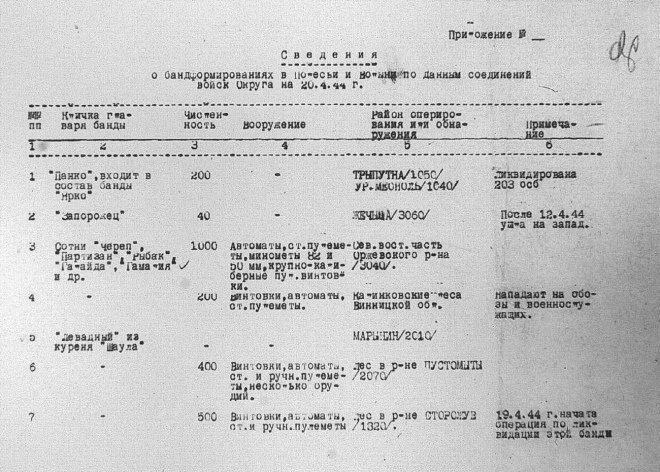
Information about the UPA units in Volynia and Polissya, which were at the disposal of the NKVD UO Headquarters as of April 20, 1944
The list of types of UPA combat actions in this paragraph clearly reflects the picture not of "banditry" but of armed resistance to the occupying army. Only a simple chronicle of military actions according to VV archival documents would take tens or even hundreds of pages. Characteristically, unit commanders repeatedly reported on operations, defeated UPA groups, and disproportionately high rates of enemy losses, but the number of "gang manifestations" and the number of "bandits" did not decrease much. And in the following months they had to conduct counter-insurgency operations again, and it all started all over again. The liberation movement demonstrated amazing viability.
The early autumn of 1944 was marked by large-scale raids by the NKVD in the Stanislav Oblast. From August 20 to September 13, the operation of the Border and Internal Troops lasted in the areas of Galych, Bogrodchany, Voinyliv, Zhovtneve, Rogatyn, and Rozhnyativ raions. Considering their own loss of 39 soldiers, the Chekists allegedly killed 2,041 UPA and OUN members, captured 1,153, while the seized weapons included 966 rifles, 107 sub-machine guns, 33 anti-tank rifles, 4 guns and 370 shells, 4 mortars and 1,772 mines, 176,554 rounds of ammunition, 22 heavy machine guns and 99 light ones, as well as other equipment.
When the Numbers do not Match
The documents of the NKVD troops are detailed and clear, but they contain a defect inherent in almost all war reports (this also applies to UPA documents): an incredible exaggeration of the enemy's losses. The true results of military operations are best calculated from sources on both sides of the front. This can be seen in a few examples.
On September 6, 1944 the Bogun Detachment of Oleksa Gromadiuk-'Ostrizky' attacked the 6th Company of the 169th Rifle Regiment of the 9th Division (50-72 soldiers), which garrisoned the village of Gryva. The commander of battalion stationed three companies on the avenues of approach to the village. At 5:20 a.m., the fourth company launched a sudden attack on the school building where the garrison was housed. The area was pelted with grenades, a fire broke out, and in a quarter of an hour the garrison stopped resisting. Rebel sources reported their loss of 20-28 dead (some soldiers managed to escape).
The 2nd Battalion of the 169th Regiment sent 18 fighters with machine guns in the direction of the sounds of the fight as reinforcements. Half a kilometer to the village, their car was ambushed by 'Nerozluchny's' company. According to Soviet data, 13 soldiers were killed, 1 went missing, and another died later from the wounds. The insurgent report claimed 16 killed, 1 captured and 1 escaped.
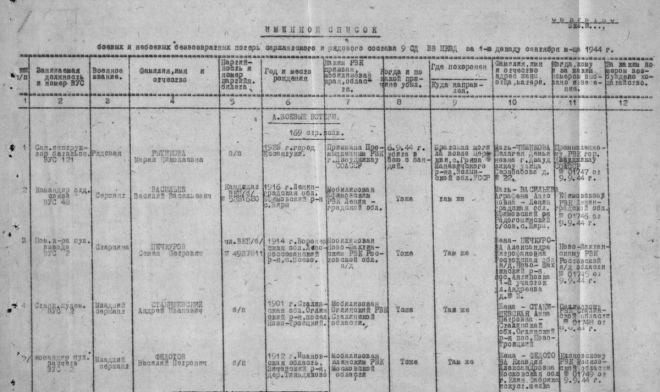
At the signal of the commander 'Ostrizky', hundreds left the village and disappeared into the woods. Enemy losses amounted to, according to the UPA reports, 36 killed and 1 captured, according to others — 40 dead. On the part of the UPA there was 1 dead and 3 wounded, including the company commander 'Nerozluchny'.
The trophies of the insurgents were: 1 Maxim machine gun, 5 Degtiarev ones, 12 sub-machine guns, 28 rifles. As we can see, the number of captured weapons (56 units) is generally correlated with the number of killed and captured enemies (as well as those who fled, leaving the weapon), which indicates the reliability of the insurgent report.
However, the reports of the 9th Division tell about their 16 dead and 4 wounded in the battle for Gryva. That is, these calculations should include both 14 killed in an ambush and those killed during the defense of the hostage, where the losses should be no less. But the losses of the enemy are listed as 45 killed "bandits", which is a clear exaggeration given the successful tactical actions of the insurgents, which were recognized by the Chekists themselves. The loss of their own weapons looks even more dubious: 8 rifles and 1 sub-machine gun for at least 16 confirmed casualties.
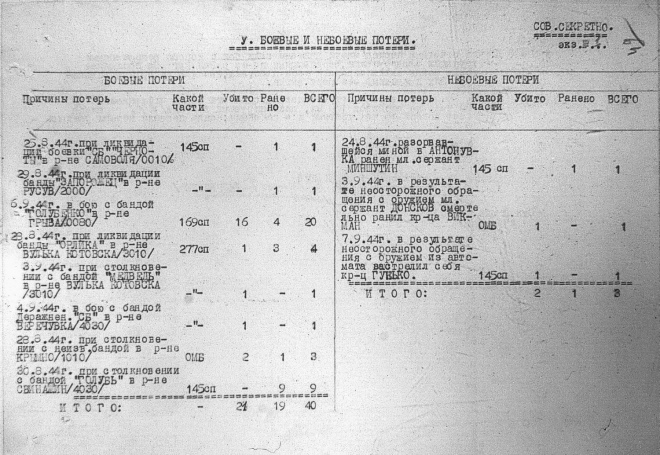
Report of the 9th Division Staff to the Headquarters of the NKVD on losses. The losses of the 169th Regiment in the battle with the 'Ostrizky' ('Golobenko') Battalion on September 6 are listed as 16 dead and 4 wounded
Another example is from Lviv region. On September 30, 1944, the Peremyshl Raion Station of the NKVD organized a military operation against the "Siromantsi" Battalion (5 companies), which was located in the Univ Forest. When the district security officers and soldiers of the 209th Battalion and an independent battalion of combat support of the 17th Brigade (a total of 460 soldiers) went on the offensive, the "Siromantsi" met them in positions prepared for defense. The battalion commander Dmytro Karpenko-"Yastrub" (a junior lieutenant of the RKKA in the past) conducted timely reconnaissance and learned about the preparation of the enemy. Instead, the Chekists did not have certain information about the composition of the battalion.
The battle lasted 8 hours, the Chekists went on the attack 13 times. "The gang was well-armed, trained militarily and put up strong resistance," the VV headquarters said. Not even tanks helped: one exploded on a mine installed in advance by the battalion, the other was hit by a faustpatron.
On the night of October 1, the "Siromantsi" broke through in small groups in the direction of Pniatyn through the disposition of the 206th battalion forces which had arrived to blockade the area. To divert attention from the main maneuver, the insurgents attacked from another direction: they opened heavy fire and drove several bulls from their unit's transport towards the Chekist positions.
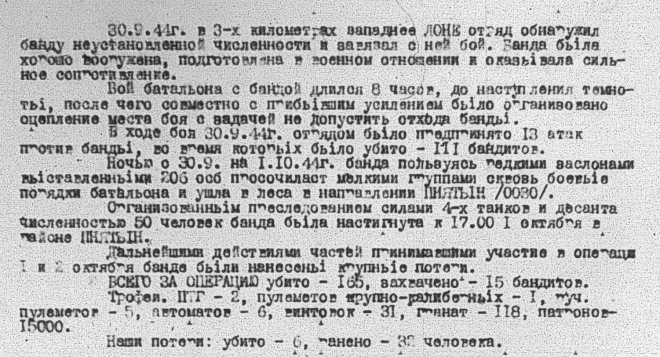
The results of the fighting, which lasted until the end of the day on October 1, according to a Soviet document, look like this: 165 insurgents were killed, 15 were taken prisoner. Own losses of Soviets were only 6 killed and 32 wounded. Trophies in weapons amounted to 31 rifles, 6 sub-machine guns, 5 handguns and 1 large-caliber machine gun, 2 anti-tank rifles, ammunition (45 weapons) — which is not enough for one and a half hundred fighters.
UPA documents say about 17-19 own losses and 200 killed enemies. It is obvious that the data on the loss of the enemy on both sides was overestimated several times. And the losses of the Soviet side should be higher, taking into account 13 failed attacks.
Whose Side Will Win?
Since the fall of 1944, the initiative has increasingly been on the side of the communist regime's forces, which have imposed defensive battles on UPA forces. So, for example, the "Galaida" Battalion of the Military District "Bug" of UPA-West was surrounded twice in a few days. At first, the unit under the command of Dmytro Pelyp-'Yevshan' was surrounded in the Sukha Lypa forest (Yavoriv Raion, Lviv Oblast) by units of the 88th NKVD Border Detachment and units of the 6th Red Army Army with tanks and planes.
After an all-day battle, the insurgents were able to break into Polish territory — in Lubaczów County. Upon returning to the Yavoriv area, the battalion had to hold a several-hour defense in the forest between the villages of Shchyrets and Ulytsko-Seredkevychi, and then break out of the encirclement in small groups.
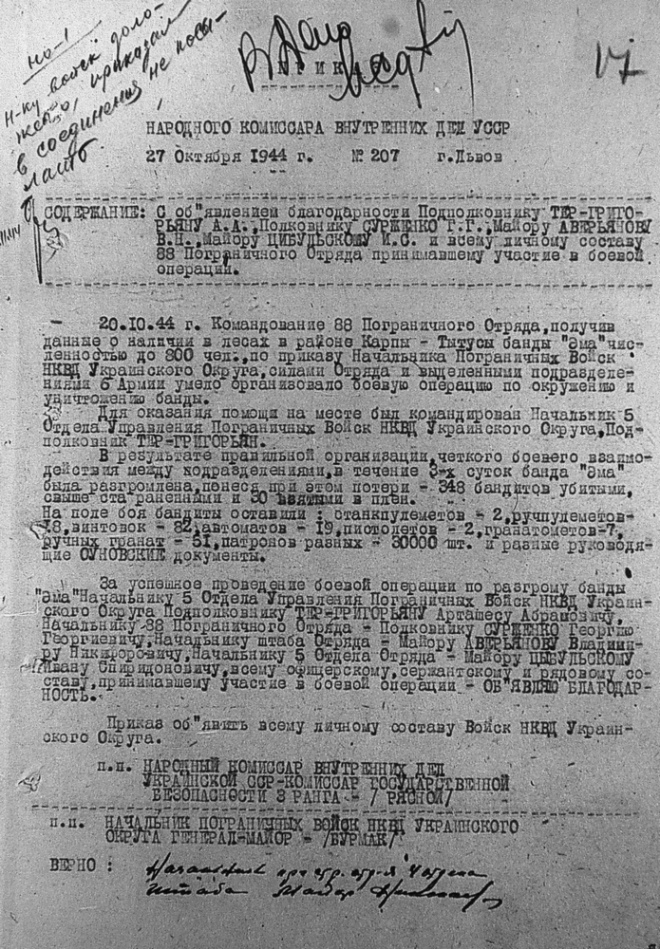
And yet, the nationalists tried to continue the offensive, and not without success. On November 18, the "Skazheni" Battalion of Vasyl Andrusiak-'Rizun' (up to 300 rifleman) broke the prison of the Tlumach raion centre of the Stanislav Oblast releasing 40 arrested insurgents.
Another raion centre of Sub-Carpathians, Solotvyn, was attacked on November 25 by the "Syvulia" Battalion under the command of 'Iskra'. In the combat, the insurgents burnt the NKVD raion station together with the chief, his family and deputy, and released 22 detainees. In total, the nationalist underground of Stanislav Oblast carried out 743 anti-Soviet actions during August-December, including 10 attacks on raion centres.
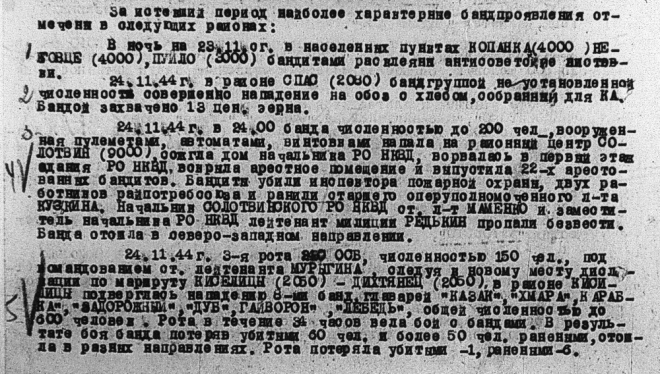
In Polissia at this time, a unit of the 1st Battalion of the 220th Border Regiment of the NKVD suffered a crushing defeat in a battle with the UPA-North Brigade "Pamyat Bazaru". 51 soldiers, led by Senior Lieutenant Vasylchenko, attacked the detachment of Gryhoriy Trotsyuk-'Verkhovynets', which came from the territory of Ukraine to Soviet Belarus and seized a height near the village Vechyshche of Divin Raion of Brest Oblast.
The fierce battle lasted 4.5 hours. Border guards had already reached the height when the soldiers of "Verkhovynets" struck them with a hail of mines and counterattacked. Vasylchenko's unit was surrounded, divided into several groups, and eventually almost completely destroyed. A Soviet report acknowledged the deaths of 29 soldiers, including the group's commander, and two others were missing. The losses among insurgents were 4 (according to their own data) or 6 (according to the Chekists).
The battle took place on the anniversary of the execution by the Chekisks of 360 captured participants of the Second Winter March of the Army of the Ukrainian People's Republic in 1921 near the village of Bazar, now Zhytomyr Oblast. Thus, the UPA-North brigade symbolically repaid the Communists for the deaths of Ukrainian soldiers.
Results: The War Continues
However, the UPA also constantly suffered losses in battles, due to arrests, desertions and soldiers' giving themselves up. According to historian I. Patryliak, the UPA-North "grew thin" by 70% in January-October 1944: 3-3.5 thousand out of 10-11 thousand fighters remained. UPA-South lost 50% of its personnel (by October there were only 500-700 soldiers out of 1-1.5 thousand in March). The situation was relatively better in the UPA-West: there were 13-14 thousand riflemen in October-November against 18 thousand in summer — that is, 20-25% less.
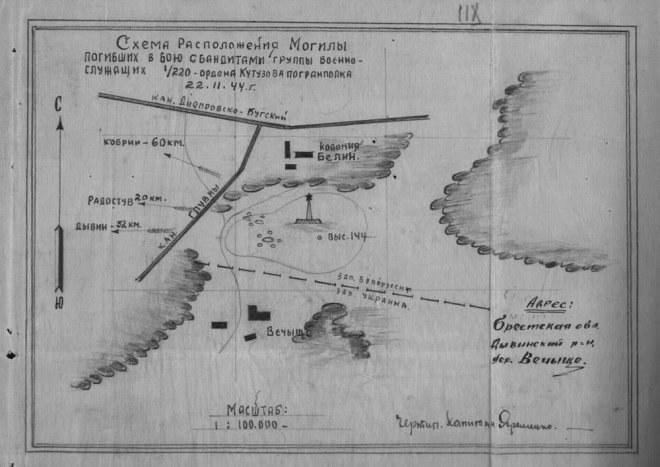
The losses in the command corps were especially sensitive — since the collision with the Soviet military machine, their level has increased markedly. During 1944, the following prominent commanders were killed:
-
April 7 — Commander of the Kremenets Battalionof UPA-South Ivan Klymyshyn-'Kruk';
-
April 10 — Commander of the Ostap Detachment of UPA-North Yaroslav Zhdan-'Ostry';
-
June 10 — group commander in the UPA-South Omelyan Hrabets-'Batko' in battle with the 189th, 203rd and 209th battalions of the NKVD.
-
July 30 — UPA-South Chief of Staff Leonid Stupnytsky-'Shymansky' in a battle with the 207th Battalion; Dmytro Korinets-'Borysten', Deputy Commander of the group "Tiutiunnyk" of the UPA-North.
-
October 15 — Fedir Poliovy-'Paul', commander of the UPA-West Officer School "Oleni" in the battle with units of the 14th NKVD Border Detachment.
-
October 23 — Commander of the "Pylyavtsi" Brigade of the UPA-North Ivan Klymchak- 'Lysy'.
-
November 5 — Dmytro Pelyp-'Yevshan', commander of the "Galaida" Battalion of UPA-West.
-
December 8 — Mykola Svystun-'Yasen', commander of the unit "Kholodny Yar" of UPA-South, in a battle with an NKVD special group.
-
December 30 — Commander of the "Siromantsi" Battalion Dmytro Karpenko -'Yastrub' and others.
Tymofiy Strokach, Head of the NKVD's Anti-Banditry Department, reported that between February and December 31, 1944, the State Security conducted 6,495 counter-insurgency operations and ambushes, during which 57,405 UPA fighters and members of the OUN underground were killed, 98,641 were arrested, and 29,202 giving themselves up. According to these statistics, on 185,250 eliminated enemies there were 18,591 rifles, 4,230 sub-machine guns, 2,588 handguns and 321 machine guns, 15 flamethrowers, 328 mortars, 4 grenade launchers, 35 guns, 32,939 grenades, 18 cars, 20 motorcycles and etc.
It turns out that either the statistics include a lot of civilian unarmed people who died and were arrested by state security, or the numbers are very exaggerated. Or even both at the same time. Otherwise, the entire rebel army, whose largest number, according to historians, did not exceed 40,000 soldiers, was completely destroyed several times in just one year.
During the year, the UPA and the OUN underground carried out 3,287 anti-Soviet actions, as a result of which the losses of troops and organs of the NKVD amounted to 5,869 people who died and were missing in action.
1944 was the first round of a duel between the Ukrainian liberation movement and the Soviet totalitarian regime for Ukraine's independence. Despite the fact that the Red Army, the NKVD rear guard, the Internal and Border Troops, the operative and agent apparatus of the NKVD and the NKGB fought against Ukrainian liberation movement, the UPA and the OUN network resisted, adapted to new realities, and changed tactics.
The Soviet regime, despite its enormous numerical advantage, did not feel like a full-fledged master of the western Ukrainian lands. The power of the Communist Party in Volynia, Galicia, and Bukovyna was held only at the point of bayonets of the NKVD troop garrisons — where there were none, it was the OUN network to have power.
The article was prepared within the project "Making the Past Accessible: Digital Return of Removed Archives on the Struggle of the USSR Against the Liberation Movement", which is implemented by the Center for the Research on the Liberation Movement with the support of the Ukrainian Cultural Foundation.
